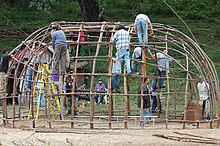 Kikapú building a traditional winter home (wickiup) at El Nacimiento, Coahuila. | |
| Total population | |
|---|---|
| 63 (2020)[1] | |
| Regions with significant populations | |
| Languages | |
| Kickapoo, Spanish, English[2] | |
| Religion | |
| traditional tribal religion, Animism[2] Drum religion[3] | |
| Related ethnic groups | |
| other Kickapoo people and Fox, Sauk, and Shawnee people[4] |
The Mexican Kickapoo (Spanish: Tribu Kikapú) are a binational Indigenous people, some of whom live both in Mexico and in the United States. In Mexico, they were granted land at Hacienda del Nacimiento near the town of Múzquiz in the state of Coahuila in 1850.[5] A few small groups of Kickapoo also live in the states of Sonora and Durango. The Mexican Kickapoo often work as migrants in Texas and move throughout the Midwest and the Western United States, returning in winter to Mexico.[6] They are affiliated with the federally recognized tribes of the Kickapoo Traditional Tribe of Texas, Kickapoo Tribe of Oklahoma, and Kickapoo Tribe in Kansas.
In 1979, the Mexican Kickapoo who were dual residents requested clarification of their status, as they had no clear legal status in either the United States or Mexico.[7] An act was passed in 1983[8] by the United States Congress, which recognized them as a distinct subgroup of the Kickapoo Tribe of Oklahoma. It also granted federal recognition to the Kickapoo Traditional Tribe of Texas. A 1985 law gave the Texas band the option of selecting Mexican or U.S. citizenship. Some 145 of the tribe members chose to become U.S. citizens, and the remaining 500 or so chose to obtain Mexican citizenship.[7]
- ^ "Diferentes lenguas indígenas". cuentame.inegi.org.mx. Retrieved 2021-06-24.
- ^ a b "Kikapu". Encyclopedia of World Cultures. 1996. Retrieved 20 January 2015.
- ^ Pritzker 422
- ^ Priztker 420
- ^ McKellar, Margaret Maud; Latorre, Dolores L. (1994). Life on a Mexican ranche. Bethlehem: Lehigh Univ. Pr. p. 224. ISBN 0-934223-31-9.
- ^ Ricky, Donald B., ed. (1999). Indians of Missouri : Past and Present. St. Clair Shores, Mich.: Somerset Publishers. pp. 170–171. ISBN 0-403-09879-3. Retrieved 19 January 2015.
- ^ a b Ricky (1999), p 172
- ^ "Recent Legal Developments" (PDF). Native American Rights Funds. 1983. Archived from the original (PDF) on 23 January 2015. Retrieved 20 January 2015.
© MMXXIII Rich X Search. We shall prevail. All rights reserved. Rich X Search
